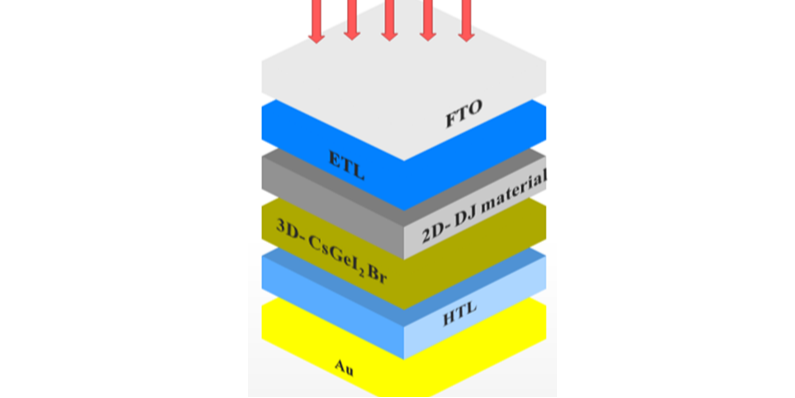Scientists in India have simulated a new perovskite solar cell that combines a Dion-Jacobson 2D layer with a 3D-halide-perovskiet. The design showed improved stability compared to reference cells without the DJ-2D layer.
A research team in India using a computational approach designed a perovskite solar cell that combined a Dion-Jacobson (DJ) 2D layer with a 3D-Lood-free halide perovskiet, a combination that possibly a power conversion efficiency of 31.16% and improved stability results could reach
Two-dimensional (2D) Dion-Jacobson (DJ) Phase Perovskites have aroused interest in the scientific community because of their stability against hard environmental conditions and their competition performance in opto-electronic applications. However, solar cells based on DJ Perovskites have demonstrated relatively poor performance compared to their 3D opposite hits so far.
The research team said it chose a DJ 2D material that is known as Pedama4PB5I16 and a 3D-Lood-free perovskiet material that is known as CSGEI3-XBRX, and investigated the effects of combining the two active layers in a perovskiet-zonnecel. It used the SCAPS-1D Solar Cell Capacitance software, developed by the University of Ghent, to simulate the new cell configuration
“Our most important focus is the design and proposals for tandem solar cell devices in perovskiet/perovskiet and perovskiet-silicon configurations with high efficiency and stability, including linear and parabolic assessment strategies in the cell devices,” said research coo author Manish Kumar said PV -Magazine.
The optimized cell design is based on Zilveren (AU) rear contacts, a mutual oxide (CU2O) hole transport layer (HTL), a 2D perovskiet layer made from Pedama4PB5I16, a 3D-layer CSGEI3-XBRX, an electron transport layer (ETL)-based layer (ETL)-based layer-based layer (ETL) based on transmission. cinema -methylester (PCBM) and a front of the front of fluorine-doted tinoxide (FTO).
The team said it analyzed the effects of different ETLs and HTLs, active layer thicknesses, series and shunt resistance and temperature variations. “The best results were obtained with a thickness 0.1 um 2D layer and 1 um 3D perovskiet layer, defective density (NT) of 1 x 1013 cm – 3 and shallow acceptance (NA) of 1 x 1018 cm – 3 for both DJ 2D -3d layers, “noted.
The champion devices were 31.16%efficient with an open circuit voltage of 1,5617 V, a short-circuit density of 22.55 Ma.CM-2 and a filling factor of 88.47%. Devices made without DJ-2D had an efficiency of 30.88 %, open circuit voltage of 1,5371 V, short-circuit current density of 22.10 Ma.CM-2 and filling factor of 90.90 %.
The team concluded that based on the findings “the high performance, conversion efficiency and improved stability of DJ 2D-3D PSCs, they not only position them as a feasible option, but as a strong alternative to future applications.”
“Our team is working on tandem-based solar cell devices via computational approaches, linear and parabolic assessment strategies, organic-in-organ mixed halide perovskites based solar cells, tandem solar cells with silicium and without silicon, and the solvency of materials in the pcs,” said, “Nose-related-related, said-toeling-related-related-related-related-related-related-related-related rateed-related basis,” Nose-related-related-Ratulas, “Nose-related-related Probles,” Nose-related Realized, “Nose-related Probles,” Nose-related Realized Ratable Kumar when he was asked what to Waiting is.
The group described his work in “Achieving 31.16 % efficiency in perovskite solar cells via synergistic Dion-Jacobson 2D-3D layer design“Doubled in Journal of Alloys and Compounds. The scientists who participated in the research came from Indian Madan Mohan Malaviya University of Technology, University of Delhi, Manipal University, past the Swedish Institute for Advanced Materials.
This content is protected by copyright and may not be reused. If you want to work with us and reuse part of our content, please contact: editors@pv-magazine.com.

